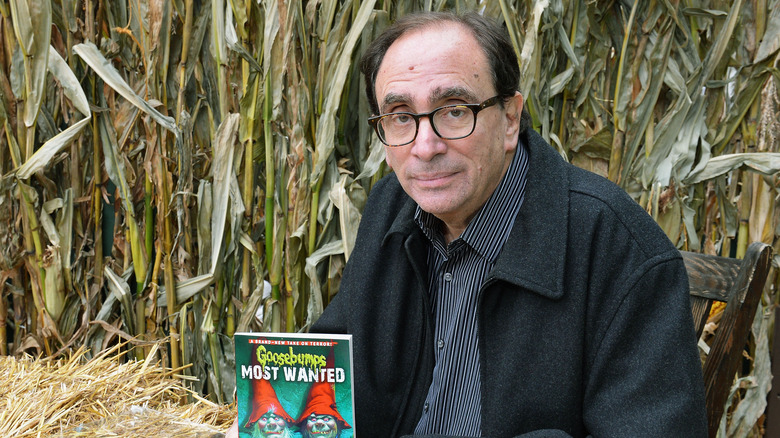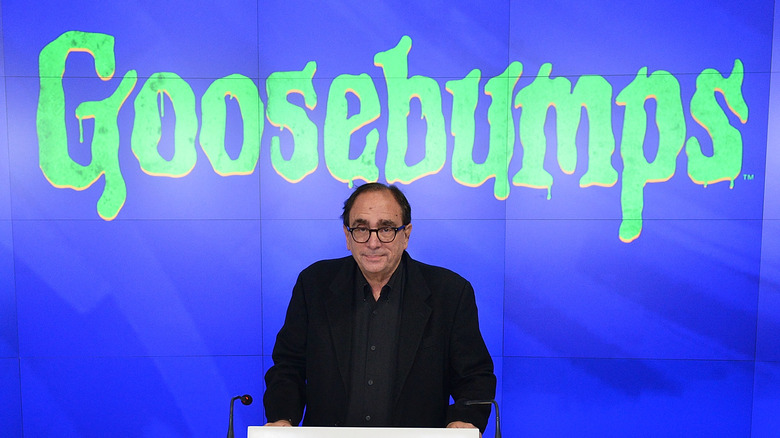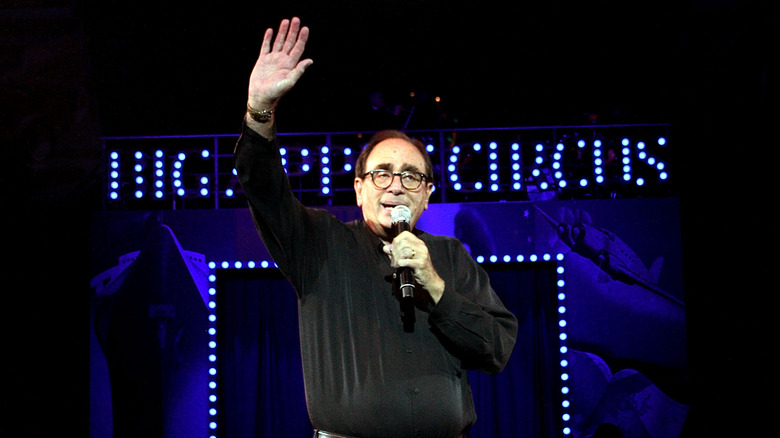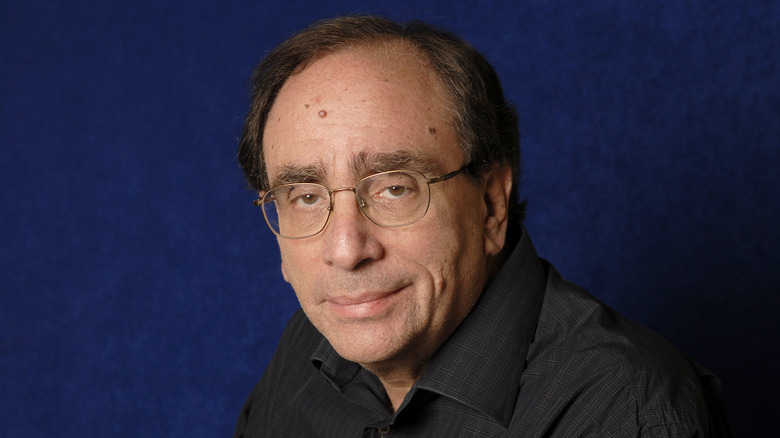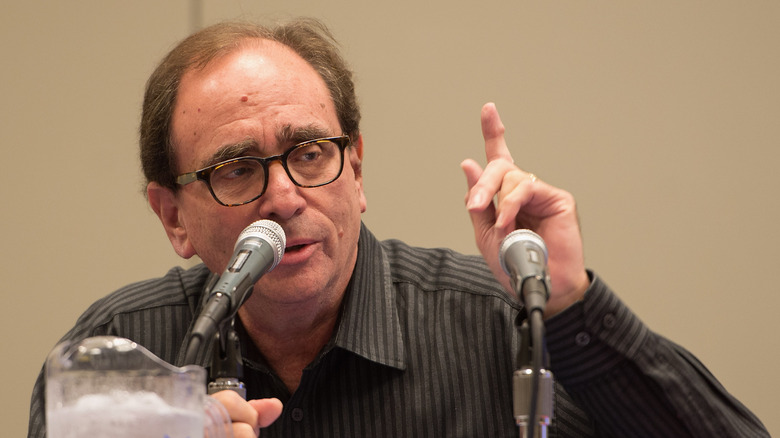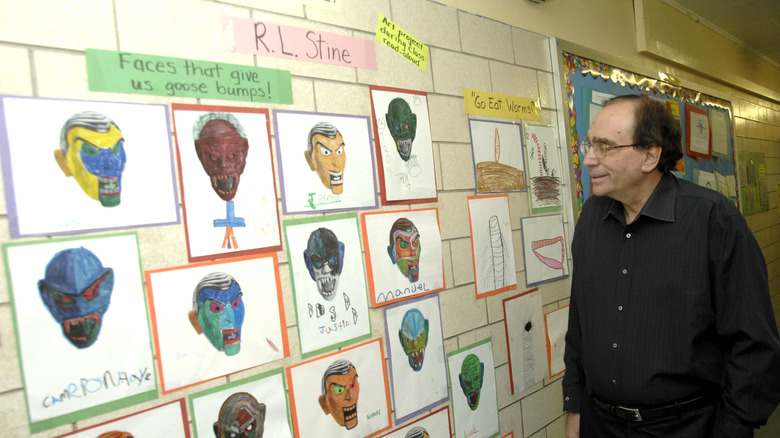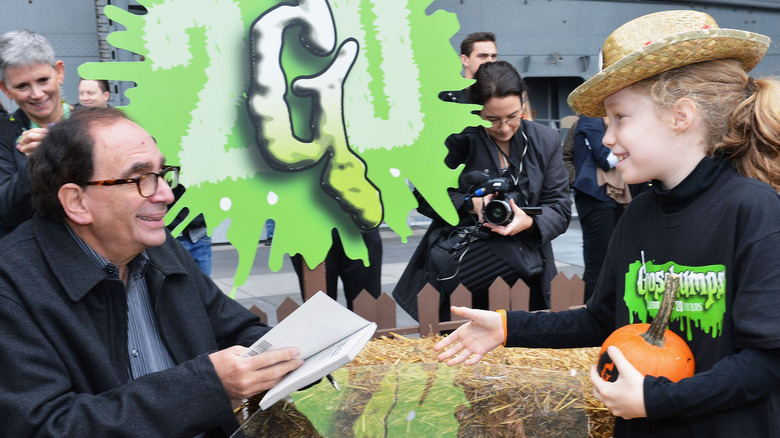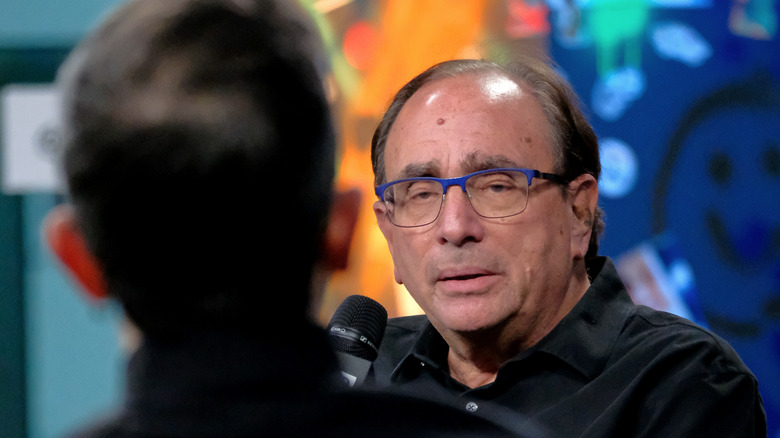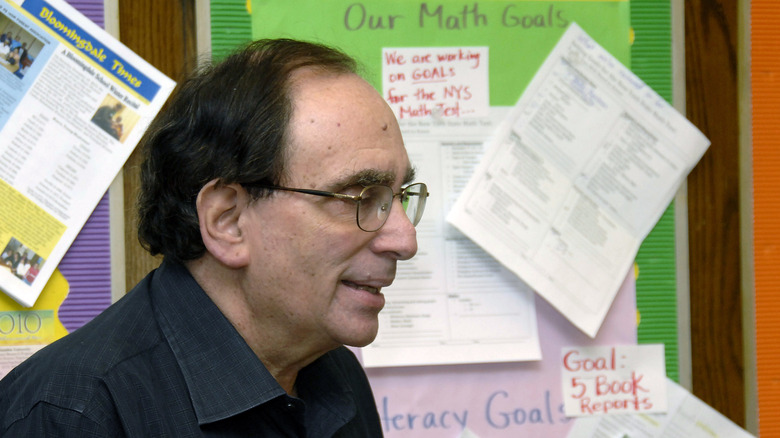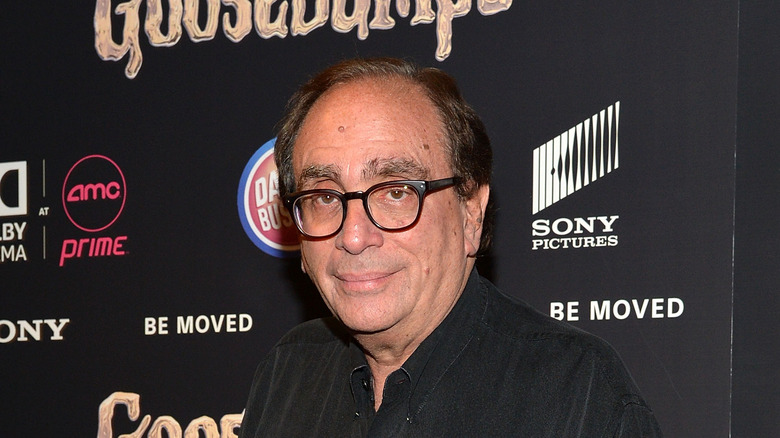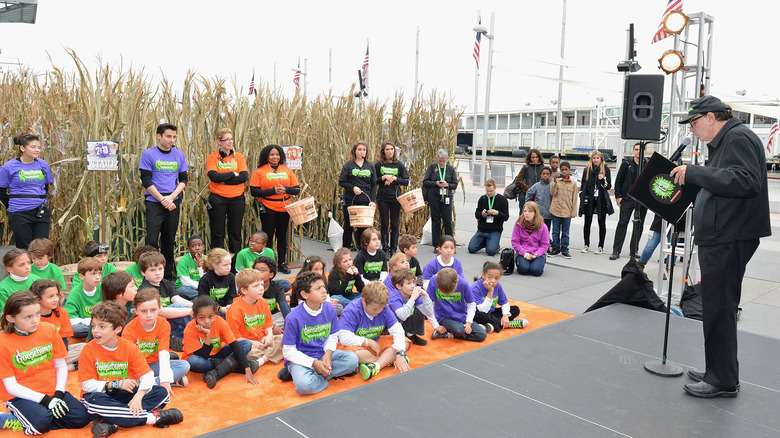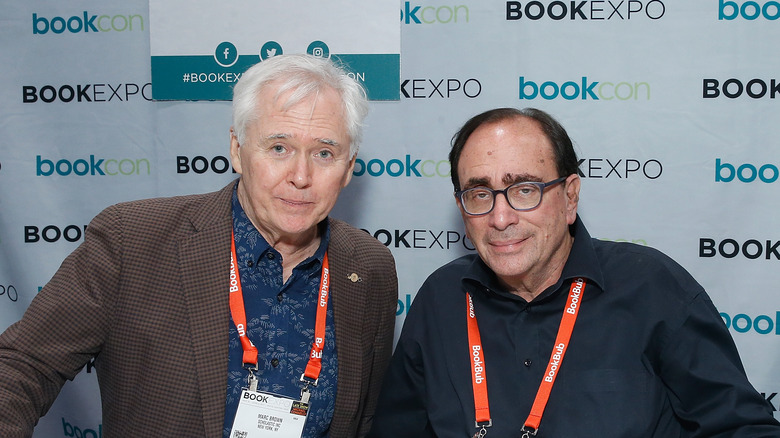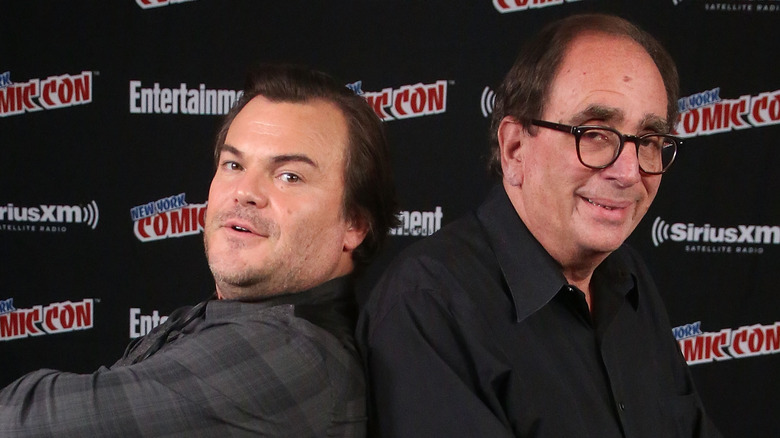The Untold Truth Of R.L. Stine
If you were born in the '80s or '90s and have a taste for the spooky and macabre (with the occasional serving of silliness on the side), chances are you're familiar with R.L. Stine. Born Robert Lawrence Stine in 1943, the Ohio author made a name for himself by writing the "Goosebumps" and "Fear Street" series. Over the years, these stories have provided thrills and chills to young book-lovers all over the world — and helped many children discover a love of reading for the first time.
According to the Irish Times, Stine has sold 400 million books since the start of his career. He's found success with adaptations, too: "Goosebumps" has been made into a TV series and a 2015 family film starring Jack Black, while the "Fear Street" series is now a three-part R-rated Netflix special.
Are you on the edge of your seat? Dying for more information about your favorite horror legend? If so, read on for some fun facts that'll give you... well, goosebumps. This is the untold truth of R. L. Stine.
Before Goosebumps, he wrote about celebrities and soft drinks
Long before he focused his attention on ghouls and goblins, R.L. Stine wrote about very different topics. According to a 2015 interview with the Verge, his first job after college was working for a fan magazine in New York. His assignment? Fabricating interviews with various celebrities of the day. "I would come in, in the morning, and [my editor] would say, 'Do an interview with Diana Ross.' So I'd sit down — type, type, type, type, type — and I'd write an interview with Diana Ross. And she'd say, 'Do an interview with The Beatles.' Fine — type, type, type — and we made it all up." While this obviously wasn't a permanent gig, Stine enjoyed it, describing it as "a great job." "It was very creative, for one thing," he says. He also credits it with teaching him to write fast, since he had to turn in "three or four" interviews every day.
Stine was a lot less fond of his next job — writing for the soft drink industry. As the assistant editor of soft drinks for a trade magazine, he wrote about such exciting topics as "new syrups and flip-top cans." "This was the worst year of my life," he told the Verge.
R.L. Stine was also a humor writer
R.L. Stine might be best known for creeping kids out with Goosebumps and Fear Street, but he didn't start out with the intention to be a horror writer. In fact, he first set his sights on humor. According to Tech Times, after his stint working in magazines, he initially took on the persona of Jovial Bob Stine, penning such lighthearted picture books as "Miami Mice" and "Gnasty Gnomes." Not only did he write silly stories for young audiences — he also published "maybe a hundred" joke books, which covered almost every topic under the sun. A quick search of "Jovial Bob Stine" will turn up volumes about everything from dogs to monsters to school cafeterias.
In 1975, Stine took his love of comedy a step further by founding a humor magazine for teens, "Bananas." The publication featured "activities, comics, and satirical advice columns," in addition to articles about popular TV stars such as Freddie Prinze and Farrah Fawcett. According to a 2015 NPR interview, Stine viewed working on the magazine as "[his] life's dream." It wasn't until 1986, when an editor asked him to write a horror novel for teens called "Blind Date," that he considered dipping his toes into the world of horror. The novel did numbers, and Stine discovered a new passion. The rest is history.
R.L. Stine wrote for adults as well as kids
According to the Cape Cod Times, R.L. Stine has been referred to as "the Stephen King of children's literature." However, he hasn't just written for kids — he's also published thrillers for adults.
Stine's first adult novel was "Superstitious," published in 1995. The book is an over-the-top supernatural mystery, just like Stine's "Goosebumps" novels, but instead of following a school-age kid, it tells the story of Sara, a grad student who marries a professor whose interest in Irish folklore seems more than just academic. According to Publishers Weekly, the characters "curse, enjoy X-rated sex and die gruesomely detailed deaths" — but other than that, the tone is similar to that of Stine's younger fare. The film rights to the book went to Miramax, but an adaptation was never made.
Stine's next book for adults was 2003's "The Sitter," about a young woman who takes a job as a nanny in the Hamptons but finds herself caring for a boy who seems "haunted by something too horrible for words." Then, in 2004, he published "Eye Candy," which is described as a "dark, sexy thriller" about a beautiful woman who receives threats from a secret admirer. (This story would receive a second life in 2015, when it was turned into an MTV series.) Per the AV Club, Stine's most recent work for older audiences is 2012's "Red Rain," a spin on the tried-and-true "evil twins" trope.
He purposely doesn't include real-world problems in his books for kids
R.L. Stine's books are full of creepy creatures, supernatural scares, and even exaggerated violence. Yet there is something he makes a consistent effort to avoid in his stories for young audiences: real-world stressors that children face. In an interview for the Verge, journalist Chris Plante questions Stine he stays away from topics such as divorce, drug use, and abuse in his writing, asking "Is it not as enjoyable for you to write?" Stine's surprising answer: "No, it's because I don't really want to terrify kids." He goes on to explain that he wants his books to serve as escapist adventures for kids — not to actually disturb them. "People always say, 'How far will you go to frighten kids?' I think if you make sure it's a fantasy world, and the kids know what they're reading is a fantasy and couldn't happen, then you can go pretty far and you won't upset them that much."
His books always have happy endings
Another one of R.L. Stine's rules is that his books always have to have happy endings. According to an interview with GEN, only once, in a book called "The Best Friend," did he deviate from this dogma. "One time in a 'Fear Street' book... the good girl is taken off as a murderer at the end. That was just for a laugh — just for me," he says. "I had the murderer get off scot-free and the good girl taken off as a murderer," he explains.
Unfortunately, Stine's switch-up backfired. Instead of being surprised by the twist, readers were infuriated by what they perceived as an injustice against a character they loved. "That book haunted me. Readers turned on me immediately," Stine says. "I got mail: 'R.L. Stine, you idiot. How could you do that? You moron. Why did you write that?'" The reaction was so intense that students would even berate him about it at school visits. When he received an influx of requests asking him to "write a sequel to finish the story," the pressure was so great that he obliged. "I've never done it again," he says.
R. L. Stine often comes up with titles first
Every writer has a different process. R.L. Stine's method of brainstorming is simple: instead of trying to spin a plot from thin air, he thinks up fun and punny phrases that would work well as titles and uses them as inspiration for his stories.
"I don't ever try to think of ideas. I just always think of titles. And then the title leads me to the story," Stine explains in a 2015 interview with NPR. He then offers an example of how this method works for him: "One day I was walking my dog in the park here in New York, and these words flashed into my mind: 'Little Shop of Hamsters.' Where? Why? I don't know what it came from." After this revelation, he investigated the title from all angles. "What could be scary about hamsters? Could maybe there be a thousand of them? Or maybe there'd be a giant hamster?"
Ultimately, "Little Shop of Hamsters" did become a Goosebumps book — as detailed on the Scholastic website, it follows a boy who works at a pet shop where "cute, little hamsters can become very UNCUTE monsters."
He's active on social media
According to Time, R.L. Stine doesn't like to write about social media or technology in his novels for kids — he doesn't want his stories to feel dated. However, that doesn't mean he's not active on social media in real life. In fact, quite the opposite.
"I'm on Twitter... [because] it's such a great way to keep in touch with the '90s kids, with my original readers," Stine tells interviewer Nolan Feeney. He shares that former readers often reach out to him to explain how he has altered the course of their lives. "All day long I hear, 'I wouldn't be a librarian today if it wasn't for you!' Or 'I wouldn't be a writer today if it wasn't for you!' Or 'Thank you for getting me through a really tough childhood.' It's very gratifying," he says.
In the interview, Stine also talks about how readers sometimes contact him to pitch story ideas via social media. "One woman wrote to me on Facebook [...] and she said, 'I have an idea for a horror novel called "The Ghost Ship," but I don't know what the plot would be. Do you think you could write it for me?'"
R.L. Stine grew up with lots of fears
R.L. Stine may be a master of scares, but he certainly wasn't fearless as a child. In an interview with Adolescent Literacy, he says that he was "afraid of lots of things" and "very shy." He elaborates on his thoughts in an interview with GEN. "I was a very fearful kid," he recounts. "I used to ride my bike around the neighborhood and come back at night and think that something was lurking in the garage, something was waiting for me, and I just hurled my bike into the garage." Pools also gave him the heebie-jeebies: "I was afraid of swimming. I didn't swim — like, let go of the side of the pool — until I was 12... It was a terrible way to grow up," he says.
Stine now theorizes that the combined forces of his shyness and phobias were what motivated him to "[stay] in his room typing." "When it came time to write these books, I could draw on that and remember that feeling of childish panic. So, in that way, I think it helped me write Goosebumps," he says.
His childhood as an "outsider" pushed him to write
R.L. Stine also credits the general feeling of being an "outsider" with inspiring him to write. In the same interview with GEN, he speaks about how his upbringing made him feel like he existed on the fringes of society. "My family was very poor," he says. "We lived on the edge of a very wealthy suburb in Columbus. The governor's mansion was two blocks away... But my family lived in a tiny little white brick house, five of us. My Dad was a blue collar worker, loading trucks. His best year he made $9,000, and here we were on the edge of all these mansions, and all the kids at school are all rich."
Stine says that this background influenced him in a crucial way: relegated to the position of outcast, he picked up a knack for studying the world around him. "[In those circumstances], you become an observer, you watch things," he states. Later, this skill would help him build immersive worlds through words in his many novels.
Ray Bradbury is one of his greatest inspirations
As a young child, R.L. Stine only read comic books. According to AdWeek, he remembers the moment when he was introduced to novels as one that would alter him permanently. One fateful day when he was 9 years old, his mother dropped him off at the library. Not seeing any of his favorite comics, he "staggered around the shelves in confusion" until "a kindly librarian spotted his plight and approached, changing his life forever" by recommending Ray Bradbury to him.
In an interview with the Strand Magazine, Stine elaborates on how the recommendation influenced his taste in literature. "I couldn't believe it, [Bradbury's] stuff was so wonderful," he says. "It was so beautifully written — the surprise endings, the great shock, which I always loved. I started reading a lot of science fiction after that. Isaac Asimov, Robert Sheckley, all those people."
Stine later had the surreal experience of meeting Bradbury in the flesh. "It's so hard to meet your heroes! I was so nervous," he says. "It was at the LA Times book festival at a campus near UCLA, and he was sitting in a booth eating a hot dog." Stine knew that he had to tell Bradbury how much he meant to him, so he strode up to him and say, "Mr. Bradbury, you're my hero." Bradbury responded well: "He said, 'Well, you're a hero to a lot of other people!' It was such a nice thing to say."
R.L. Stine was a guest star on Arthur
Many of the children who grew up on "Goosebumps" and "Fear Street" will also remember "Arthur" fondly. It turns out that the children's TV show, which has aired on PBS Kids since 1996, has some surprising connections to R.L. Stine.
Stine and his Goosebumps series were lovingly parodied in the "The-Scare-Your-Pants-Off-Club," the 28th episode of the show's first season. According to the Arthur Fandom Wiki, Arthur and his friends become obsessed with a series of spooky books called "The Scare-Your-Pants-Off Club," clearly a spin on the "Goosebumps" books. When some overbearing parents try to get the books banned, the kids must unite to save the day. According to WGBH ("Arthur"'s production company), in 2019, Stine became a part of the show in a special way: he guest starred as Buster's Uncle Bob, a horror writer.
In addition to his moments on the show, Stine has collaborated with "Arthur" creator Marc Brown on two children's stories. As reported by Entertainment Weekly, the first picture book is titled "The Little Shop of Monsters," and its follow up is "Mary McScary."
He's incredibly prolific — and doesn't plan on stopping anytime soon
R.L. Stine has written novels for kids for over 30 years. According to GEN, he used to write a new "Goosebumps" or "Fear Street" book every two weeks. "To have that kind of success suddenly was so exhilarating. I think it kept me going. I had to do 20 pages a day... I'm kind of amazed myself just saying it," he reminisces. Today, his writing pace isn't quite as frantic, but he's still far more prolific than most authors: he writes four "Goosebumps" books and two "Fear Street" books every year, and works on other projects such as graphic novels at the same time.
Does Stine plan on stopping? Absolutely not. When asked "Is there a time when you think you might hang up the hat?" his answer is a firm no. "I don't think authors retire," he replies. "I think of Robert B. Parker, who just dropped dead on the keyboard. I think that's the way to go. Anyway, I just signed on to do six more 'Goosebumps' books. Maybe some of them will be posthumous, I don't know," he quips.
